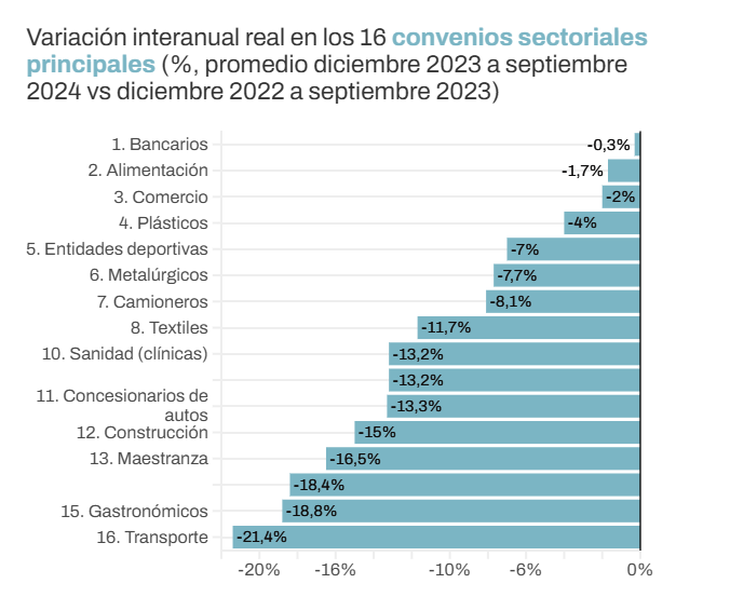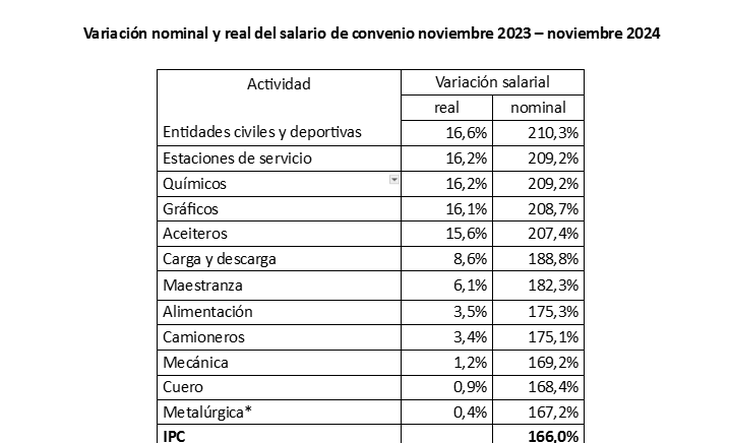The arrival of Javier Milei to the Government brought a significant change in the salary dynamics. The beginning of his administration was marked by a devaluation that affected both registered and unregistered workers. However, those who have access to joint negotiations They achieved a faster recovery compared to the informal and state employees, who, unlike the former, suffered a deterioration in their income due to the “ceiling” they set for monthly increases.
Among the sectors that managed to overcome inflation were the workers of sports and civil entities stand outservice station employees, chemists, graphics, oil and banking workers.
A study prepared by Fundar showed that in the dynamics of income there were heterogeneous situations. For example, they highlighted, university teachers had a salary deterioration of -25%, public employees -23%, private household employees -21%, unregistered salaries -19% and registered private salaries of -9%. A case worth highlighting is that those who charge Universal Child Allowance are the only ones who managed to stay safe in the face of inflation with a real growth of 27%.
found4.png
According to Fundar, the Heterogeneity in salary evolution was also manifested between public and private employees, mainly in collective bargaining. “With the change of presidency, spending on salaries in the public sector suffered a significant cut, explained both by massive layoffs and by a salary negotiation that did not keep pace with inflation“, notes the report. This resulted in a real drop of 22% in public salaries between November and January, a significantly larger reduction compared to the private sector, where the loss was 12%.
Within the private sector, the less favorable performances were associated with delays in the signing of agreements (or in a delayed approval by the Ministry of Labor) and intermittent increases that failed to compensate for past inflation. On the contrary, the best performing sectors adopted strategies such as shorten the duration of agreements and establish monthly increases.
It is important to highlight that a trend noted in previous notes on monthly salary increases was the advance of unions that implemented adjustments in some cases automatically, in others, exceeding inflation or incorporating adjustments for the following month. These measures, combined with additional bonuses, allowed many private sector workers to experience a salary recovery, especially in the second half of the year when, when, at the same time, economic activity also showed signs of some recovery.
salaries.png

The salary analysis: first quarter vs second quarter
Luis Campos, researcher at Institute of Studies and Training and Coordinator of the CTA Social Law Observatory Autonomous shared Scope an interesting report entitled “Choose your own adventure”. In it he analyzes the salary dynamics during Javier Milei’s first year.
“The salary in the first quarter accompanied inflation, although at much lower levels. The story was different again starting in the second quarter, when the average salary in the private sector began to recover positions until it almost equaled the situation prior to the devaluation, while in the public sector that growth was much milder, perceptible only in the coldness of a calculation sheet,” Campos explained.
According to their analysis, in the public sector the salary drop was a constant, without exceptions. On the contrary, in the private sector “dispersion” prevailed, with marked differences between unions and agreements.
The report also emphasizes the variation between real and nominal values, offering a detailed table with the performance of each union.
slarios11.png

Source: CTA Social Law Observatory.
“This phenomenon is not new, but it is possible that 2024 has been the year with the greatest sectoral disparity within registered private sector joint ventures. Both in the frequency and magnitude of the agreements, the absence of relatively homogeneous guidelines or patterns was the norm during the year,” Campos stated.
Finally, looking ahead to 2025, leading economists anticipate an economic rebound. Although projections vary around 3% growth or slightly higher, The consensus suggests that the salary dynamics will not repeat the 2024 scheme. That is, salaries are expected to be more aligned with inflation. According to Campos, The axis of the debate in 2025 will not revolve so much around sectoral differences, but rather the “impact on economic activity and employment.”
Source: Ambito
I am an author and journalist who has worked in the entertainment industry for over a decade. I currently work as a news editor at a major news website, and my focus is on covering the latest trends in entertainment. I also write occasional pieces for other outlets, and have authored two books about the entertainment industry.




